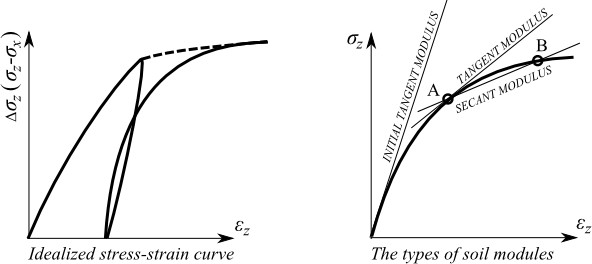Basic Data
The following material parameters are required for all material models.
Unit weight γ - the unit weight of a dry soil (soil above the groundwater table, GWT) is assumed. The unit weight of a soil below the GWT is calculated from other parameters introduced in section "Uplift".
Modulus of elasticity E
The modulus of elasticity describes the material stiffness that is assumed constant over the entire load interval. In case of soils this assumption is, however, valid only for a very narrow interval of recoverable deformations. Modulus of elasticity E has no significant effect on soil behavior for nonlinear models after satisfying plasticity condition.
A straightforward answer to what definition and what value of this material parameter (initial, tangent, secant) one should use in a given material model is, unfortunately, not available. To select a given type of modulus one needs know the soil behavior in the analyzed geotechnical task and to assign a particular magnitude the results from a triaxial test for corresponding stress paths are necessary. Nevertheless, certain recommendations can be provided.
 Distribution of idealized stress-strain curve and determination of individual types of soil modules
Distribution of idealized stress-strain curve and determination of individual types of soil modules
The following interpretation of Young’s modulus E of elasticity is available:
- instantaneous modulus E0 in case of small loads (assumption o linear dependence of strain and stress) or when instantaneous settlement is calculated
- secant modulus E50 is determined for a reference stress equal to 50% of stress at the onset of failure (used for example when analyzing spread foundations and settlement of pile foundations)
- deformation modulus Edef is determined from a stress-strain curve derived experimentally. This modulus is required when using the modified elastic model, which it assumes different behavior for load and unloading. Using this modulus when solving the problem of soil unloading (e.g., underground structures, heaving of bottom a foundation ditch) leads to larger deformations than when using the elastic modulus Eur determined from unloading branch r of the stress-strain curve. Determining of deformation modulus of soil is applicable by following approximate relation:
![]()
- oedometric modulus Eoed which depends on the level of stress in the soil should be used depending on the expected range of stress in the soil may experience. The relation between Edef and Eoed is provided by:
![]()
![]()
where: | ν | - | Poisson's ratio |
Edef | - | deformation (secant) modulus |
- modulus of elasticity Eur determined from the unloading branch of stress-strain curve is used when solving the problem of soil unloading (excavations) - must be defined when using the modified elastic model
The values of modules of elasticity should be determined, if possible, from a triaxial shear test. If other methods (penetration tests, pressuremeter tests etc.) are used then it becomes necessary to introduce some correlation coefficients are described in literature.
For actual modeling we recommend to perform an analysis according to the elastic material model at first and check the resulting strain field - such strains according to Hookes’s law are linearly dependent on the applied load and the used elastic modulus. If the resulting strains (displacements) are already too large the user should reassess the magnitude of the originally applied elastic modulus.
Poisson's ratio ν - coefficient of transverse contraction is in case elastic homogeneous material loaded by normal stress in one direction given by:
![]()
where: | εy | - | vertical strain |
εx | - | horizontal strain |
The Poisson's ratio is relatively easy to determine. To select its value one may take advantage of the built-in soil database. If small loads are assumed and the instantaneous modulus E0 is used, then also the value of the Poisson's ratio ν0 determined for the initial loading should be employed.